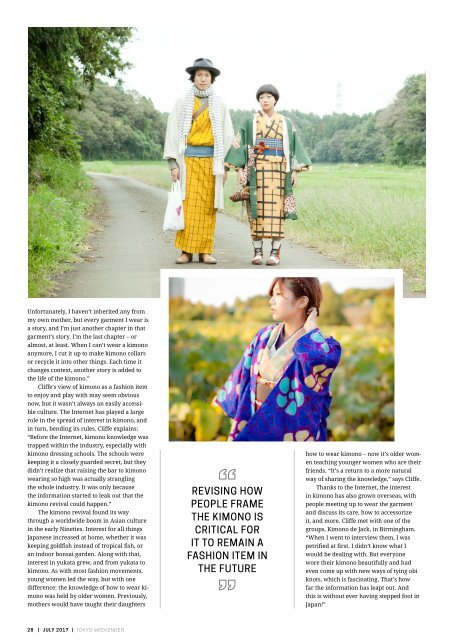Tokyo Weekender July 2016
Breaking the rules of kimono – a new book shatters antiquated views of this traditional garment. Plus: The boys for sale in Shinjuku Ni-chome, best sake of 2017, Japan's new emperor, and what really goes on inside "Terrace House."
Breaking the rules of kimono – a new book shatters antiquated views of this traditional garment. Plus: The boys for sale in Shinjuku Ni-chome, best sake of 2017, Japan's new emperor, and what really goes on inside "Terrace House."
You also want an ePaper? Increase the reach of your titles
YUMPU automatically turns print PDFs into web optimized ePapers that Google loves.
Unfortunately, I haven’t inherited any from<br />
my own mother, but every garment I wear is<br />
a story, and I’m just another chapter in that<br />
garment’s story. I’m the last chapter – or<br />
almost, at least. When I can’t wear a kimono<br />
anymore, I cut it up to make kimono collars<br />
or recycle it into other things. Each time it<br />
changes context, another story is added to<br />
the life of the kimono.”<br />
Cliffe’s view of kimono as a fashion item<br />
to enjoy and play with may seem obvious<br />
now, but it wasn’t always an easily accessible<br />
culture. The Internet has played a large<br />
role in the spread of interest in kimono, and<br />
in turn, bending its rules. Cliffe explains:<br />
“Before the Internet, kimono knowledge was<br />
trapped within the industry, especially with<br />
kimono dressing schools. The schools were<br />
keeping it a closely guarded secret, but they<br />
didn’t realize that raising the bar to kimono<br />
wearing so high was actually strangling<br />
the whole industry. It was only because<br />
the information started to leak out that the<br />
kimono revival could happen.”<br />
The kimono revival found its way<br />
through a worldwide boom in Asian culture<br />
in the early Nineties. Interest for all things<br />
Japanese increased at home, whether it was<br />
keeping goldfish instead of tropical fish, or<br />
an indoor bonsai garden. Along with that,<br />
interest in yukata grew, and from yukata to<br />
kimono. As with most fashion movements,<br />
young women led the way, but with one<br />
difference: the knowledge of how to wear kimono<br />
was held by older women. Previously,<br />
mothers would have taught their daughters<br />
REVISING HOW<br />
PEOPLE FRAME<br />
THE KIMONO IS<br />
CRITICAL FOR<br />
IT TO REMAIN A<br />
FASHION ITEM IN<br />
THE FUTURE<br />
how to wear kimono – now it’s older women<br />
teaching younger women who are their<br />
friends. “It’s a return to a more natural<br />
way of sharing the knowledge,” says Cliffe.<br />
Thanks to the Internet, the interest<br />
in kimono has also grown overseas, with<br />
people meeting up to wear the garment<br />
and discuss its care, how to accessorize<br />
it, and more. Cliffe met with one of the<br />
groups, Kimono de Jack, in Birmingham.<br />
“When I went to interview them, I was<br />
petrified at first. I didn’t know what I<br />
would be dealing with. But everyone<br />
wore their kimono beautifully and had<br />
even come up with new ways of tying obi<br />
knots, which is fascinating. That’s how<br />
far the information has leapt out. And<br />
this is without ever having stepped foot in<br />
Japan!”<br />
28 | JULY 2017 | TOKYO WEEKENDER
















